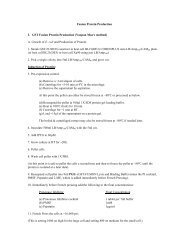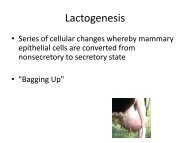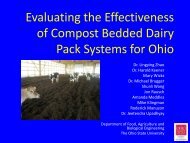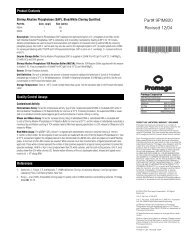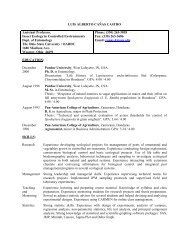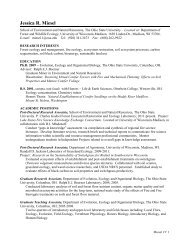Sumagic Sprays for Height Control of Tomato and
Sumagic Sprays for Height Control of Tomato and
Sumagic Sprays for Height Control of Tomato and
You also want an ePaper? Increase the reach of your titles
YUMPU automatically turns print PDFs into web optimized ePapers that Google loves.
FloriBytes<br />
Digital newsletter <strong>for</strong><br />
the floriculture industry<br />
FloriBytes is prepared by members <strong>of</strong> the<br />
Floriculture Industry Roundtable <strong>of</strong> Ohio which is<br />
financially supported by OFA <strong>and</strong> The Gus Poesh<br />
Fund.<br />
Beth Fausey<br />
Charles Behnke<br />
Claudio Pasian<br />
Dave Dyke<br />
Dean Krauskopf<br />
Denise Ellsworth<br />
Dennis Lew<strong>and</strong>owski<br />
Hal Kneen<br />
Luis Cañas<br />
Year IV. Issue 6 October 2009<br />
I) GREENHOUSE MANAGEMENT<br />
<strong>Sumagic</strong> <strong>Sprays</strong> <strong>for</strong> <strong>Height</strong> <strong>Control</strong> <strong>of</strong> <strong>Tomato</strong> <strong>and</strong> Pepper<br />
Transplants<br />
By Dr. Rebecca Schnelle<br />
University <strong>of</strong> Kentucky<br />
rebecca.schnelle@uky.edu<br />
Jonathan Frantz<br />
Jim Locke<br />
Michelle Jones<br />
Nancy Taylor<br />
Peter Ling<br />
Ray Cloyd<br />
Roberto Lopez<br />
Steve Carver<br />
Tim Malinich<br />
Rebecca Schennele<br />
For years, there have been no plant growth regulators (PGRs) labeled <strong>for</strong> use on<br />
vegetable transplants. Recently, a supplemental label <strong>for</strong> <strong>Sumagic</strong> (Uniconazole) has been<br />
released to allow foliar sprays on some vegetable transplants (tomato, pepper, ornamental<br />
pepper, eggplant, tomatillo, ground cherry, <strong>and</strong> pepino). The new label is rather restrictive,<br />
however. The maximum total allowed application is 10 ppm at 2 quarts per 1000 sq ft. This<br />
means one 10 ppm spray, two 5 ppm, or four 2.5 ppm sprays <strong>and</strong> so on are allowed. The<br />
last spray must be no later than 2 weeks after the 2-4 leaf stage (approximately 4 weeks after<br />
sowing). Within these guidelines, we conducted a series <strong>of</strong> experiments to determine the<br />
effects <strong>of</strong> sumagic rate <strong>and</strong> application date on height control <strong>of</strong> peppers <strong>and</strong> tomatoes. We<br />
found that <strong>Sumagic</strong> is highly active in both peppers <strong>and</strong> tomatoes. All <strong>Sumagic</strong> treated plants<br />
were shorter than the untreated controls at marketable age (6 weeks after sowing).<br />
Seeds <strong>of</strong> three cultivars <strong>of</strong> peppers („Better Belle‟, „Big Bertha‟, <strong>and</strong> „Hungarian Yellow<br />
Wax‟) <strong>and</strong> three cultivars <strong>of</strong> tomatoes („Big Boy‟, „Early Girl‟, <strong>and</strong> „Champion II‟) were sowed<br />
into 36 cell trays on 29 May 2009 in greenhouses located in Lexington KY. We sprayed the<br />
1
seedlings with 0, 2.5, 5, or 10 ppm <strong>Sumagic</strong> at 2, 3, or 4 weeks after sowing. Some plants<br />
also received split applications at 2.5 or 5 ppm. We recorded plant heights when the<br />
transplants were at a market ready stage at six weeks after sowing (10 July).<br />
Timing <strong>of</strong> Spray Effects<br />
In all cases, the sprays applied 2 weeks after sowing produced shorter plants than<br />
those applied at 3 or 4 weeks after sowing. This is likely the result <strong>of</strong> a combination <strong>of</strong><br />
preventing early stretch <strong>and</strong> more <strong>of</strong> the <strong>Sumagic</strong> absorbing into the media than the foliage.<br />
Two weeks after sowing both the peppers <strong>and</strong> tomatoes were at the 1-2 true leaf stage which<br />
left the media mostly exposed to the spray. This makes sense, as we know from previous<br />
research that sumagic <strong>and</strong> other triazoles like paclobutrazol are more active when applied to<br />
the media. Figure 1, which shows the final heights <strong>of</strong> Champion II tomatoes sprayed with 2.5<br />
ppm <strong>Sumagic</strong> illustrates this effect. It is vital <strong>for</strong> growers to underst<strong>and</strong> that the earlier the<br />
sumagic spray is applied, the greater effect it will have on the final height <strong>of</strong> the transplants.<br />
If additional height control is required, a split application can be made. The<br />
photographs in Figure 2 show „Big Boy‟ tomato transplants that were sprayed with 2.5 ppm<br />
<strong>Sumagic</strong>. The initial spray was applied at 2 weeks after sowing then additional sprays were<br />
applied one or two weeks later. The additional sprays at 3 or 4 weeks after sowing did<br />
provide additional height control. In this case however, the single spray at 2 weeks after<br />
sowing produced the most desirable plants <strong>for</strong> the retail market.<br />
Cultivar <strong>and</strong> Rate Effects<br />
The three tomato cultivars showed very similar responses to <strong>Sumagic</strong> with each spray<br />
rate (Figure 3). Each rate <strong>of</strong> sumagic produced plants <strong>of</strong> similar size at the market ready<br />
stage. However, those treated with the higher rate would probably take longer to grow out <strong>of</strong><br />
the treatment. This could be problematic as both commercial tomato growers <strong>and</strong> consumers<br />
expect tomato plants to grow rapidly immediately after transplant. This will be discussed in<br />
more detail in the subsequent sections. I recommend that growers use the lower rate to<br />
prevent any post harvest complications. <strong>Sumagic</strong> has not been tested on enough tomato<br />
cultivars to be sure that they will all react similarly. As with any new PGR program, onsite<br />
testing <strong>of</strong> small portions <strong>of</strong> the crop is recommended be<strong>for</strong>e full scale implementation.<br />
In general, the pepper plants show much more sensitivity to <strong>Sumagic</strong> than tomatoes.<br />
The three pepper cultivars varied in their responsiveness to <strong>Sumagic</strong> sprays. While all were<br />
highly sensitive, Hungarian yellow wax pepper plants were less responsive to <strong>Sumagic</strong> than<br />
the two bell pepper varieties, „Better Belle‟, <strong>and</strong> „Big Bertha‟ (Figure 4). The photos in Figure<br />
5 show the appearance <strong>of</strong> „Better Belle‟ peppers following sprays <strong>of</strong> up to 10 ppm. Those<br />
treated with 10 ppm were severely stunted <strong>and</strong> would not be marketable. Given this high<br />
sensitivity, I would not recommend that growers use sumagic on pepper transplants until we<br />
can investigate the effect <strong>of</strong> rates lower than 2.5 ppm. In most cases negative DIF or other<br />
non-chemical height control measures should be sufficient to produce marketable pepper<br />
transplants.<br />
Post Harvest Concerns<br />
There is clearly a risk <strong>of</strong> undesirable side effects <strong>of</strong> PGR application to fruiting crops,<br />
namely delayed flowering <strong>and</strong>/or reduced fruit size. Some preliminary work found that<br />
sumagic treated tomato plants actually bore fruit earlier than controls in commercial field<br />
2
production with no reduction in fruit size. Although not conclusive; it appears that the treated<br />
plants experienced less transplant stress than the controls. This intuitively makes sense to<br />
all <strong>of</strong> us PGR users. We know that PGR treated plants require less water so it only makes<br />
sense that they will need less water when first transplanted to the field or garden as well as in<br />
the retail environment. We are planning another set <strong>of</strong> experiments next spring to look into<br />
the effects <strong>of</strong> sumagic sprays during the transplant stage on fruit timing, size <strong>and</strong> yield in<br />
more detail.<br />
Of course, <strong>for</strong> many home gardeners the exact timing <strong>of</strong> the harvest, fruit size <strong>and</strong><br />
yield are not a major issue. With the recent increase in interest in home food production I<br />
think we need to take care to ensure that these new customers have the most gardening<br />
success possible. We certainly would not want a rash <strong>of</strong> unexplained marble-sized tomatoes<br />
or an outbreak <strong>of</strong> “never-grow-again syndrome”. With these concerns in mind I conducted a<br />
small post harvest screening in my home garden. While certainly not replicated, controlled or<br />
in any way scientific I still feel these observations are worth sharing. I planted three each <strong>of</strong><br />
the control, 2.5, 5, <strong>and</strong> 10 ppm treated „Better Belle‟ pepper plants in my garden on July 15 th .<br />
I did notice that the treated plants wilted later than the control plants, but all survived<br />
transplanting. The 5 <strong>and</strong> 10 ppm treated plants produced much smaller fruits some <strong>of</strong> which<br />
had a sour flavor. This is exactly what we do not want to see in consumers‟ gardens.<br />
Following this experience, I would encourage growers to avoid <strong>Sumagic</strong> on sweet bell<br />
peppers at this time. Additional research will be needed to confirm these observations <strong>and</strong><br />
determine the effects <strong>of</strong> <strong>Sumagic</strong> on other pepper types.<br />
Conclusions <strong>and</strong> Recommendations<br />
For production <strong>of</strong> retail tomato transplants in 6-packs I recommend applying an initial<br />
sumagic spray at 1 to 2.5 ppm 2 weeks after sowing. If additional height control is needed,<br />
up to 3 additional applications <strong>of</strong> 1 to 2.5 ppm can be made weekly. Until we know more<br />
about the post harvest effects <strong>and</strong> the range <strong>of</strong> cultivar sensitivity we recommend growers<br />
stay away from the higher rates <strong>of</strong> 5 or more parts per million. Again I want to emphasize<br />
that caution is paramount as sumagic sprays are implemented in vegetable transplant<br />
programs. It doesn‟t take too many bad experiences <strong>for</strong> a gardener to decide they must have<br />
a brown thumb. With that said I believe sumagic sprays on tomatoes hold great promise to<br />
allow us to produce better quality transplants that have the potential <strong>for</strong> improved survivability<br />
in the retail <strong>and</strong> home garden settings.<br />
3
Figure 1. Average heights <strong>of</strong> market ready „Champion II‟ tomato transplants treated<br />
with 2.5, 5, or 10 ppm sumagic 2,3, or 4 weeks after sowing.<br />
a b c d<br />
Figure 2. From left to right, (a) control <strong>and</strong> „Big Boy‟ tomatoes sprayed with 2.5 ppm sumagic<br />
at (b) 2 weeks only, (c) 2 <strong>and</strong> 3 weeks, <strong>and</strong> (d) 2,3, <strong>and</strong> 4 weeks after sowing. The photos<br />
were taken 6 weeks after sowing.<br />
4
Figure 3. Average heights <strong>of</strong> market ready „Champion II‟, Early Girl‟, <strong>and</strong> „Big Boy‟<br />
tomato transplants with sumagic sprays <strong>of</strong> 2.5 to 10 ppm applied 2 weeks after<br />
sowing.<br />
Figure 4. Average heights <strong>of</strong> market ready „Hungarian Yellow Wax, „Big Bertha‟, <strong>and</strong><br />
„Better Belle‟ pepper transplants with sumagic sprays <strong>of</strong> 2.5 to 10 ppm applied 14 days<br />
after sowing.<br />
5
Figure 5. From left to right, untreated control <strong>and</strong> „Better Belle‟ pepper plants treated with 2.5,<br />
5, <strong>and</strong> 10 ppm <strong>Sumagic</strong> sprays 2 weeks after sowing. The photo was taken 6 weeks after<br />
sowing<br />
6



